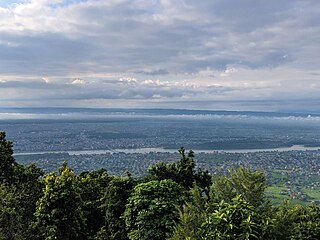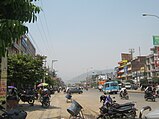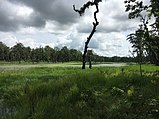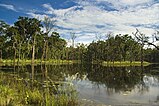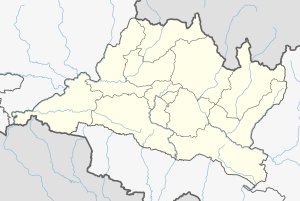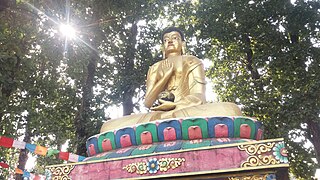|
Bharatpur, Nepal
Bharatpur (/bəˈrɑːtpər/, Nepali: भरतपुर, pronounced [ˈbʱʌɾʌt̪pur] ⓘ) is a city in south central Nepal. It is the third most populous city of Nepal after Kathmandu and Pokhara with 369,377 inhabitants in 2021.[2] It is also the second largest metropolitan city in Nepal by area. It is the district headquarter of the Chitwan District.[3] Bharatpur is one of the fastest-growing cities in Nepal.[4] It lies on the eastern bank of the Narayani River and serves as a commercial center of the Chitwan district and the central region of Nepal. Most of the shopping area lies in the area of Narayangadh, while government offices, hospitals and colleges are situated in other parts of the city, including Nepal's premier cancer hospital, B.P Koirala Memorial Cancer Hospital. In March 2017, Bharatpur was declared a metropolitan city after Narayani Municipality, Chitrawan Municipality and Kabilas Village were merged into it.[5] EconomyThe economy of Bharatpur is traditionally based on agriculture. The city also holds a small-scale processing industry that mostly processes the food surpluses of the Chitwan district. Their products are sold to major cities of Nepal, Kathmandu and Pokhara.[citation needed] The poultry industry is expanding in the municipality, producing a significant amount of poultry products for the country, and is one of the main employment sources in the Chitwan District.[6] Other products from the city include honey, mushrooms, and flowers. A significant part of its economy is derived from education and health services. DemographicsAt the time of the 2021 Nepal census, Bharatpur Metropolitan City had a population of 369,268. Of these, the linguistic distribution was as follows: - 73.3% spoke Nepali - 5% spoke Tharu - 5% spoke Gurung - 3.8% spoke Magar Dhut - 3.6% spoke Tamang - 2.7% spoke Bhojpuri - 2.6% spoke Nepalbhasha (Newari) - 0.7% spoke Maithili - 0.7% spoke Darai In terms of ethnicity/caste: - 32.1% were Brahman - Hill - 12.4% were Kshetri - 8.8% were Gurung - 6.7% were Magar - 5.9% were Bishwokarma - 5.7% were Tamang - 5.6% were Tharu - 5.4% were Newa (Newar) - 2.3% were Pariyar - 2.2% were Kumal In terms of religion: - 83.6% were Hindu - 12.9% were Bouddha - 1.4% were Islam - 0.1% were Kirat - 1.6% were Christian - 0.1% were Prakriti - 0.3% were Bon - 0.00% were Jain - 0.00% were Baháʼí - 0.00% were Sikha Ethnic Groups in Bharatpur (2021) Hill Brahmin (32.1%) Kshetri (12.4%) Gurung (8.8%) Magar (6.7%) Bishwokarma (5.9%) Tamang (5.7%) Tharu (5.6%) Others (22.0%)
Language in Bharatpur (2021) Nepali (73.3%) Tharu (5%) Gurung (5%) Magar Dhut (3.8%) Tamang (3.6%) Bhojpuri (2.7%) Others (10.0%)
Ward ProfilePresidents of Wards[8]
Climate
Tourist attractionsBishazari Tal Bishazari Tal, meaning "Lake twenty thousand", is in south Bharatpur. The lake serves as a bird watching center and houses many crocodiles. Bishazari Tal lies near Chitwan National Park and 5 km (3.1 mi) south of the city center, Chaubiskoti, of Bharatpur. Pandeyghumti is the nearest chowk (square) from the lake, being only 1 km (0.62 mi) away. Chitwan National Park Nearby, Chitwan National Park चितवन राष्ट्रिय निकुञ्ज is home to one-horned rhinos, elephants, Bengal tigers, crocodiles, deer and many other wild animals. It is the third largest tourist destination in Nepal after Kathmandu and Pokhara. The park has been listed in the UNESCO World Heritage List since 1983. Narayani RiverThe Narayani River flows north to south in the south of Bharatpur. It is the deepest and one of the largest rivers in Nepal. The Narayani Bridge over this river connects Chitwan District with Nawalpur District of Nepal. Small islands, like Nagarban in Narayani river, are popular picnic spots. Rapti RiverThe Rapti River flows east to southwest in the south of Bharatpur and meets the northern border of the Chitwan National Park. Religious and cultural landmarks
Forts and palaces
EducationBharatpur's Chitwan Higher Secondary School is the oldest government school in Chitwan District.[10] There are several colleges in Bharatpur, including the College of Medical Sciences, Bharatpur and Chitwan Medical College. The city's most famous institution is the Agriculture and Forestry University, which was established in 2010 and is the first technical university in Nepal.[11] HealthcareCompared to other parts of the country, Bharatpur has a highly developed healthcare system with several famous hospitals, including the second-largest government hospital in Nepal, which was established with American aid during the malaria control program operated by the US government at the request of the late King Mahendra of Nepal. B.P. Koirala Memorial Cancer Hospital was established with the help of China in 1994.[12] Two medical colleges, the College of Medical Sciences and Chitwan Medical College also maintain their own teaching hospitals.[13][14] Other important hospitals and nursing homes are Niko Children's Hospital, Narayani Community Hospital, Sishu Fertility Clinic, and Bharatpur Eye Hospital. Transportation Bharatpur is located at the crossing of Mahendra Highway and Madan Ashrit Highway. The closest larger cities are Gorkha Municipality at 67 km (42 mi) and Hetauda at 78 km (48 mi). Kathmandu is located 146 km (91 mi) away. Bharatpur is the only city in Nepal that has two operating airports.[citation needed] Bharatpur Airport, in the central part of the city, offers daily flights to Kathmandu and to Pokhara. Meghauli Airport is a smaller airstrip in the southwest of the city. Public transportation consists of privately run bus or microbus services.[citation needed] There are also frequent bus services to Kathmandu and Birgunj. Public bus service is available to the people from the city to Danda of Nawalpur District, Butwal, and other major cities and small villages and towns too. SportsThe under construction Gautam Buddha International Cricket Stadium is situated in the city. The Chitwan Rhinos represented the city and Chitwan as a whole in the Nepal Premier League. MediaEight major local FM radio stations are broadcast from Bharatpur. They are Amrit FM, Synergy FM, Hamro FM, Radio Triveni, Radio Chitwan, Chitwan Online FM. Kalika music FM, and Kalika FM. The television stations Beso Channel, Avass TV, and Crystal TV also broadcast from Bharatpur.[15] NarayangarhNarayangarh (Nepali: नारायणगढ) or Narayanghat (Nepali: नारायणघाट pronounced [naɾajʌɳɡʱaʈ], or [naɾajʌnɡʌɽ]) is an important trading area, which is situated in the centre of Bharatpur. The major neighbourhoods of Narayangarh are Shahid Chowk, Pulchowk, Kshetrapur, Belchowk, Hakimchowk and Milanchowk. Narayangarh is famous for Taas, a spicy fried goat-meat lunch dish served with bhuja or chiura. Narayangarh has extremely hot summers but very mild winters. Sister citiesGallery
See alsoReferences
|
||||||||||||||||||||||||||||||||||||||||||||||||||||||||||||||||||||||||||||||||||||||||||||||||||||||||||||||||||||||||||||||||||||||
